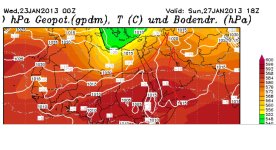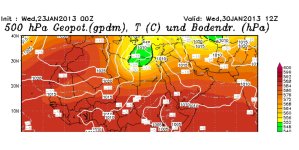Frigid Air Grips Big Part of U.S.; Is There A Tropical Link?
- Published: January 22nd, 2013
75 52 6 0

By
Andrew Freedman
Follow @afreedma
The coldest air of the winter season is affecting millions from the northern Plains to New England this week, where temperatures are running well below average, and wind chills are plunging into dangerous territory. The cold weather is likely to stick around for much of the week, and repeated blasts of colder-than-average temperatures are anticipated into February as a possible result of a variety of factors, including a
sudden warming event in the upper atmosphere above the Arctic, and a natural cycle of tropical rainfall variability near the Equator.

Infrared satellite image as of Tuesday morning, Jan. 22. The yellow shading in southern Canada and the northern U.S. indicates very cold air.
Click to enlarge the image. Credit: NOAA.
On Tuesday afternoon, the heart of the cold air mass was located over the northern Plains and Upper Midwest, extending eastward into northern New England. In Duluth, for example, the temperature dropped to -21°F on Tuesday morning and temperatures were even lower in northern Minnesota, with International Falls reaching -30°F with a wind chill in the dangerous range between -40 and -50°F.
In Minneapolis, the record streak of days with high temperatures of 0°F or greater came to an end on Monday, when the high temperature was -2°F. The record streak lasted 4 years and 6 days, shattering the previous record by 324 days. Before Jan. 21, 2013, the last time the high temperature at the Minneapolis airport was below zero was on Jan. 15, 2009, when the thermometer climbed to only -6°F, the National Weather Service (NWS) said.
In Milwaukee, the low temperature on Monday was -5°F, which was noteworthy because of the lack of snow cover in that city. Snow cover enhances cooling on clear, cold nights, and reduces daytime temperatures by reflecting incoming sunlight. Therefore, it is often difficult to get such cold temperatures without the assistance of snow cover.
According to the NWS, there have been only 17 instances since 1948 when the low temperature reached or dipped below 0°F with no snow cover on the ground. The most recent occurrence was Jan. 20, 2008, when the low temperature was -6°F.
In Chicago, the temperature at noon on Tuesday was just 4°F, making it one of the coldest days in the Windy City in two years. The low temperature on Monday night was -3°F at Chicago’s Midway Airport.
The colder-than-average conditions are proving to be an especially big shock to many because last winter was extraordinarily mild across much of the U.S. The winter of 2011-12 was the
fourth-warmest on record in the lower 48 states, with 27 states recording temperatures that ranked among their top 10 warmest winters. Snow cover was also far below average last year. According to the Rutgers University Global Snow Lab, wintertime snow cover extent in the Lower 48 states was the third smallest in the 46-year satellite record. The only winter seasons that had smaller snow cover extents were the winters of 1991-92 and 1980-81.
In contrast, this winter's snow cover has been above average across the U.S., although there are some areas that have missed out on the action so far.
Chicago, for example, has had just 1.3 inches of snow, which is a paltry 8 percent of its typical seasonal snow total to date, according to the
WGN TV Weather Center blog. South Bend, Ind., has had only 9.8 inches of snow, which is a little more than 2 feet below average to date.
The combination of the cold air and strong winds is creating dangerously low wind chill readings in parts of the Great Lakes and in Northern New England, where wind chills are dipping to between -40 and -50°F. Wind chill this low can rapidly lead to frostbite, and the NWS has issued
wind chill warnings from Maine to Michigan in response to these conditions. Farther south, in New York City Philadelphia, and Washington, D.C., conditions were generally colder than typical readings at this time of year, but nowhere near as severe.

Map of wind chills, or apparent temperatures, on Tuesday morning, Jan. 22.
Click to enlarge the image. Credit: NOAA.
The turn to colder weather in much of the East may be related to two factors in particular. One is a sudden warming event that took place high in the atmosphere, in a region known as the stratosphere. This
sudden stratospheric warming event, which occurred in late December into early January, may be drawing cold air away from the Arctic and into the northern mid-latitudes, while the Arctic enjoys relatively mild temperatures.
While the physics behind sudden stratospheric warming events are complicated, their implications are not: such events are often harbingers of colder weather in North America and Eurasia. The ongoing event favors colder and possibly stormier weather for as long as four to eight weeks after the event, meaning that after a mild start to the winter, the rest of this month and February could bring the coldest weather of the winter season to parts of the U.S., along with a heightened chance of snow.
Sudden stratospheric warming events take place in about half of all Northern Hemisphere winters, and they have been occurring with increasing frequency during the past decade,
possibly related to the
loss of Arctic sea ice due to global warming.
Arctic sea ice declined to its smallest extent on record in September 2012.
In addition to the sudden stratospheric warming event, there may be another natural climate phenomenon at work as well. According to Michelle L'Heureux, a climate scientist at the
Climate Prediction Center, which is part of the
National Oceanic and Atmospheric Administration (NOAA), a phenomenon known as the
Madden-Julian Oscillation, or MJO, also favors colder-than-average conditions in parts of the U.S. right now, and may even be a bigger factor than the more dramatic stratospheric warming event.
L'Heureux has been studying ways to use the
status of the MJO to predict large-scale weather patterns beyond a two-week lead time, when forecasts using current techniques tend to diminish.
The
MJO is associated with a pattern of tropical rainfall that moves eastward along the equator, going around the world in about 30-to-60 days. Because the MJO influences atmospheric heating through tropical rainfall, it can modify weather patterns far away from the equator.
In a
study published in the journal Climate Dynamics in 2012, L’Heureux and her colleagues found that when the MJO is located in a particular phase, as it is now, it can favor more cold air outbreaks over the eastern U.S.

Image showing an area of heavy tropical rains associated with the MJO in the Western Pacific Ocean. (Scientists use outgoing longwave radiation as a proxy for locating areas of persistent, heavy precipitation.)
Click to enlarge the image. Credit: NOAA/CPC via Michelle L'Heteureux.</p>
“The MJO is presently located in a position that favors increased tropical rainfall over the central Pacific (and decreased rainfall over the eastern Indian Ocean-Maritime Continent),” L’Heureux said in an email conversation. “This pattern is most significantly linked to more cold air outbreaks over the eastern U.S.”
L’Heteureux said stratospheric warming events tend to take several weeks to show any impact on North American weather, and that this cold air outbreak may be occurring too soon after the event to be directly attributed to it. She said it’s more likely that the sudden stratospheric warming event will lead to a cold February in parts of the U.S.
“It will be a lot easier to evaluate this cold air outbreak retrospectively, as opposed to doing it on the fly . . . but given how strong the MJO is right now I just cannot imagine it not being the predominant influence,” she said.




































